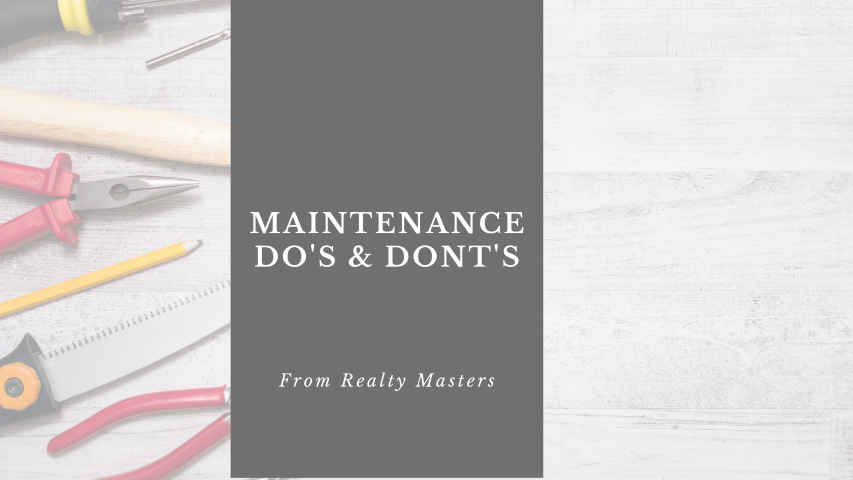
Very often maintenance problems or damage to your fixtures can easily be prevented with a little knowledge and common sense. We encourage you to read this section BEFORE a problem can occur. Residents may be held liable for certain maintenance problems which can be directly attributed to negligent usage.
ELECTRICITY:
If you experience an electrical outage of any sort the first place to check is your breaker box. Chances are a circuit has been overloaded and the breaker needs to be reset. Try flipping each switch on the box off and back on again to reset the breakers. Make sure you only do this once as problems can result from activating and suddenly cutting off the power surge. If the electricity does not come back on, check all of your outlets to be sure they are not being overloaded.
If the electricity has gone out in your entire home and resetting the breaker does not restore it, it is likely that there has been a power failure. A good indicator of a power failure would be to check if you notice outside lights on your neighbor’s house are off as well. The gas and electric company should be notified. You should then call your emergency service number to report the problem.
If the electricity is off in only part of your home and resetting the breakers does not restore it, it is possible that you have experienced an electrical short. Lack of electricity in the majority of your home may qualify as an emergency after hours if it affects your refrigerator or other vital areas of your home.
**IF AT ANY TIME YOU NOTICE SPARKS COMING FROM A SWITCH OR ELECTRICAL FIXTURE TURN OFF THE SWITCH AND UNPLUG THE APPLIANCE IMMEDIATELY. Call the problem in and leave the switch off until maintenance professionals or contractors can respond.
ELECTRICAL APPLIANCES:
Before calling for service on any appliance be sure the cord is securely plugged in and the breaker is not tripped.
- REFRIGERATORS:
The refrigerator will operate most efficiently if the temperature is set between 3 and 8. To determine the best setting, test the temperature of the items inside and adjust accordingly. The freezer setting may be too high if freezer items form ice coating shortly after placing them inside. If you do not have a frost-free refrigerator, the freezer should be defrosted when the ice that forms on the side is no more than 1/4 inch thick. A heavy build-up of frost can severely limit the effectiveness of your unit and increase the electric cost on the utility bill. To defrost the freezer, we recommend placing all items in a cooler and turning the control knob to off or defrost. Allow the ice to melt by placing a pan of hot water inside the freezer. NEVER USE KNIVES OR ANY OTHER OBJECT TO REMOVE ICE! This can cause irreparable damage for which you may be held liable. If your refrigerator fails to operate properly, please call for service.
- OVEN/RANGE:
Keeping your oven clean is very important to the efficient operation of the appliance. In addition, a buildup of grease or food particles left inside or on the stove can facilitate fires. It is best to wipe off the top and inside after each use. A moist towel and mild soap can be used to clean food or grease which has not baked onto the surface. Always place food on a baking sheet or aluminum foil inside the oven. To keep grease from building up on drip pans we suggest wrapping foil tightly around the pan itself, being sure to cover the center hole. When the foil becomes stained, in can simply be removed and replaced with fresh foil. Drip pans and the outside aluminum rings are chargeable to the resident upon moving out when they must be replaced due to negligence.
- DISHWASHER:
Be sure to scrape food particles from dishes into the garbage before placing them in the dishwasher. Use only detergents which are specified for use in dishwasher. Before running the dishwasher, make sure that the bottom of the washer bas been cleared of any items which may have fallen there. Make sure all dishes are secure onto the rack, putting bowls and pots on the top rack to keep from blocking water circulating to other areas. Dishwashers should never be left to run in your absence. An undetected leak can cause major damage to floors or carpeting if left unattended. If you notice any water escaping from the dishwasher or the unit fails to operate properly, please turn the machine off and call for service.
- GARBAGE DISPOSAL:
Disposals operate virtually trouble-free when used properly. Please read and carefully follow the procedures outlined below to prevent jammed disposals and clogged drains:
- Turn cold water on to maximum flow position.
- Flip the switch to the on position.
- Push refuse through the splash guard keeping hands away from the inside chamber.
- Continue to run the disposal until the grinding sound stops. Then flip switch to the off position.
- Continue to run cold water for two to three minutes to be sure all of the waste particles have been flushed away.
Below are some Do’s and Don’ts for disposal usage:
DO:
*Grind a citrus peel or put baking soda down the drain periodically to keep the disposal odor free.
*Run plenty of cold water during and after operation.
*Grind coffee grounds and eggshells.
DON’T:
*Put your hand down a disposal when it is running – NEVER!
*Use hot water when operating a disposal.
*Try to put too much through the disposal at once.
DO NOT PUT ANY OF THE FOLLOWING ITEMS INTO A DISPOSAL:
Fibrous materials (cornhusks, artichokes, etc) Clam, oyster or nut shells
- Bones Drain cleaner
- Tea Bags Potato or Banana Peels
- Celery Tomatoes
- Grease Wooden objects
- Glass, China or Plastic Dishrags
Metal objects (bottle caps, aluminum foil, Tin cans, or utensils)
If the motor has stopped due to overloading, turn the disposal off. Wait three to five minutes, then push the reset button (often located under the sink on the unit itself). Then follow normal operating procedures.
If the disposal is jammed, turn the power switch to off before attempting to remove any object. With tongs, remove any object that might be inserted into the mouth of the disposal and turn in a circular pattern to free the blades. Once the movement has been restored to the blades, push the reset button on the disposal unit. Then follow normal operating procedure.
PLUMBING:
In the event that a toilet or drain stops up, a plunger is often all that is needed to clear the blockage. The following will help determine what to do if you experience a plumbing problem. If it cannot be corrected please call the office for service.
- COMMODE:
If your toilet should overflow, you can turn off the water supply by turning the shut-off valve in a clockwise direction. The shut-off valve is located under the toilet tank. The water flow can also be stopped by pushing the flap firmly over the hole in the bottom of the tank.
If the toilet is stopped up, try using a plunger to clear the blockage. If this does not clear the blockage and you must call for service you may be charged for the visit if it is determined to be due to over stuffing or foreign objects. If you have only one bathroom a non-usable toilet will be treated as an emergency after hours. Otherwise, the other toilet(s) can be used until maintenance can correct the problem.
There are several items that should never be put into a toilet. These include, but are not limited to, paper towels, feminine products, grease, disposable diapers, bottle caps(or any small metal or plastic items), newspapers, or drain cleaner.
- CLOGGED DRAINS:
Never put grease or hair down a drain.
Always attempt to clear the blockage with a plunger. If that is unsuccessful, use draino or another similar product and let it set for the recommended time on the back of the bottle.
If you are unable to clear the drain, please call for service.
originally posted 12-01-2017

